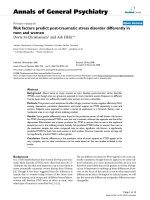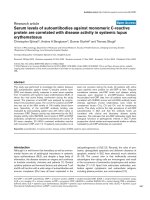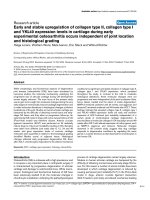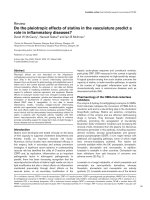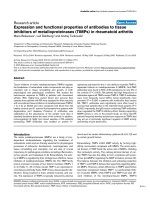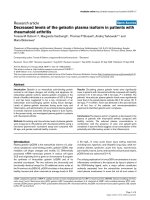Báo cáo y học: "APOBEC3G levels predict rates of progression to AIDS" ppsx
Bạn đang xem bản rút gọn của tài liệu. Xem và tải ngay bản đầy đủ của tài liệu tại đây (455.99 KB, 7 trang )
BioMed Central
Page 1 of 7
(page number not for citation purposes)
Retrovirology
Open Access
Hypothesis
APOBEC3G levels predict rates of progression to AIDS
Xia Jin*
1,2
, Hulin Wu
3
and Harold Smith
4
Address:
1
Departments of Medicine, University of Rochester, Rochester, New York 14642, USA,
2
Departments of Microbiology and Immunology,
University of Rochester, Rochester, New York 14642, USA,
3
Department of Biostatistics and Computational Biology, University of Rochester,
Rochester, New York 14642, USA and
4
Department of Biochemistry and Biophysics, University of Rochester, Rochester, New York 14642, USA
Email: Xia Jin* - ; Hulin Wu - ; Harold Smith -
* Corresponding author
Abstract
Background: APOBEC3G (hA3G) is a newly discovered cellular factor of innate immunity that
inhibits HIV replication in vitro. Whether hA3G conferrs protection against HIV in vivo is not known.
To investigate the possible anti-HIV activity of hA3G in vivo, we examined hA3G mRNA abundance
in primary human cells isolated from either HIV-infected or HIV-uninfected individuals, and found
that hA3G mRNA levels follow a hierarchical order of long-term nonprogressors>HIV-
uninfected>Progressors; and, hA3G mRNA abundance is correlated with surrogates of HIV disease
progression: viral load and CD4 count. Another group later confirmed that HIV-infected subjects
have lower hA3G mRNA levels than HIV-uninfected controls, but did not find correlations
between hA3G mRNA levels and viral load or CD4 count. These conflicing results indicate that a
more comprehensive, conclusive investigation of hA3G expression levels in various patient cohorts
is urgently needed.
Presentation of the hypothesis: For exploring whether hA3G abundance might influence HIV
disease progression, we have formulated a hypothesis that inlcudes two parts: a) in vivo, the basal
hA3G mRNA expression level per PBMC is a constant – with minor physiologic fluctuations –
determined by host genetic and epigenetic elements in a healthy individual; and that the basal hA3G
mRNA expression levels in a population follow a Normal (or Gaussian) distribution; b) that
although HIV infects randomly, it results in more rapid disease progression in those with lower
hA3G mRNA levels, and slower disease progression in those with higher hA3G mRNA levels.
Testing the hypothesis: This hypothesis could be tested by a straighforward set of experiments
to compare the distribution of hA3G mRNA levels in HIV-uninfected healthy individuals and that
in HIV-infected, antiretroviral therapy-naïve subjects who are at early and late stages of infection.
Implication of the hypothesis: Testing this hypothesis will have significant implications for
biomedical research. a) It will link hA3G to the mechanisms underlying slower disease progression
in long-term nonprogressors. And, b) It may help to establiseh a new prognostic marker, the hA3G
abundance measurement, for HIV-infected patients.
Published: 20 March 2007
Retrovirology 2007, 4:20 doi:10.1186/1742-4690-4-20
Received: 9 November 2006
Accepted: 20 March 2007
This article is available from: />© 2007 Jin et al; licensee BioMed Central Ltd.
This is an Open Access article distributed under the terms of the Creative Commons Attribution License ( />),
which permits unrestricted use, distribution, and reproduction in any medium, provided the original work is properly cited.
Retrovirology 2007, 4:20 />Page 2 of 7
(page number not for citation purposes)
Background
In the absence of antiretroviral therapy, most HIV-
infected individuals die of AIDS within 8–10 years of
infection. Some of them, however, have a substantially
slower rate of disease progression and have been catego-
rized as long term nonprogressors (LTNPs), who are usu-
ally clinically asymptomatic, and having high CD4 counts
and low HIV viremia levels [1]. These LTNPs offered
unique opportunities to study correlates of protective
immunity. Potential protective mechanisms in LTNPs
include infection by defective or less fit HIV variants, hav-
ing strong host immune responses, and possession of
unique host genetic elements including CCR5 genotype
and HLA haplotypes [1-19]. Current consensus is that
each known factor only plays some degree of protection,
and unknown protective host factors may yet to be discov-
ered.
APOBEC3G (apolipoprotein B mRNA-editing enzyme,
catalytic polypeptide-like 3G; also known as CEM15, or
hA3G) is a novel cellular factor of innate immunity that
inhibits HIV replication in vitro by causing G to A hyper-
mutations, and consequently reduced relative infectivity
of each virus produced by infected cells [20-22]. HIV
counters hA3G activity by using Vif protein to bind and
target hA3G protein for enhanced degradation through
proteasomal pathways [21,22]. hA3G also has antiviral
activities against other viruses including SIV, hepatitis B
virus (HBV) and murine leukemia virus (MLV) [23-32].
Some recent studies, however, suggest that causing G to A
mutations may not be the only mechanism by which
hA3G exercises its antiviral activity, at least in vitro [25,33].
Whereas others reported that hA3G induced G to A hyper-
mutations might be a major mechanism of virological
control in vivo [34]. Additionally, it was reported that the
activation of peripheral blood mononuclear cell (PBMC)
will modified the hA3G from a low-molecular-mass
(LMM) complex to a high-molecular-mass (HMM) com-
plex, thus abrogating its antiviral effect. It was also sug-
gested that in addition to the known mechanism of
making G to A hypermutations, the LMM hA3G might
exert post-entry restriction of HIV replication in resting
primary CD4+T cells and monocytes [35].
Overall, there is currently a relative paucity of human
research data. We propose a hypothesis that reconciles
these published data using human cells [34,36,37]. Test-
ing this hypothesis will have implications for a better
undersanding of the HIV pathogenesis; the development
of a new diagnostic tool; as wells as providing scientific
basis for the therapeutic strategy that targets Vif protein or
Vif-hA3G interections.
Presentation of the hypothesis
Why is there individual variation in hA3G mRNA expres-
sion level in recent reports [36,37]? We hypothesize that
in vivo, the basal hA3G mRNA expression level per PBMC
is a constant – with minor physiologic fluctuations –
determined by host genetic and epigenetic elements in a
healthy individual; and that the basal hA3G mRNA
expression levels in a population follow a Normal (or
Gaussian) distribution. Figure 1 uses distribution "a" to
illustrate two major features of the hypothesis: 1) the
hA3G mRNA levels of most subjects concentrate around
the mean value of ū; and, 2) the remaining subjects have
values falling on either side of the mean (as a value of
"z"). The hypothesis would predict the following sce-
nario:
At the initial time of infection (Time 0, Fig 2), HIV ran-
domly infects individuals with differential hA3G mRNA
abundance. According to the relative hA3G mRNA abun-
dance, these HIV-infected subjects could be stratified into
low, medium, and high hA3G subsets. Each patient
group's hA3G levels will still form a Normal distribution
(distribution b, c, and d, respectively; Fig 1). Collectively,
though, the distribution of hA3G mRNA abundance
among HIV-infected and uninfected subjects will overlap
initially, albeit the population size of HIV-infected will be
smaller than that of the HIV-uninfected. After a period of
HIV infection (Time X, Fig 2), when patients' viremia
reach steady-state levels and their clinical stages become
stable, there will be several testable outcomes for the dis-
tribution. If hA3G level has no effect on HIV disease pro-
gression, the distributions of hA3G level in HIV-infected
and HIV-uninfected individuals will overlap because sub-
sets of HIV-infected patients who have varying hA3G lev-
els should have similar attrition rates. If hA3G plays a
protective role, one should expect increased survival of
those with higher hA3G levels, such that the overall hA3G
levels will shift to the right in comparison to that of nor-
mal HIV-uninfected controls. If hA3G plays a detrimental
role, then its distribution in HIV-infected patients will
shift to the left (Fig. 2).
To generalize the hypothesis, we can designate a mean
value for hA3G abundance to each subject population of
interest. Let (i) the HIV-uninfected subjects maintained
the same distribution (as shown in Fig 1), with a mean of
ū; (ii) individuals with higher hA3G mRNA abundance
that are enriched for LTNPs have a mean of a
¯
; and, (iii)
other HIV-infected subjects have a mean of ē. Assuming
the proportion of LTNP in the entire HIV-infected popu-
lation is W, then we would have
ū = Wa
¯
+ (1-W)ē.
Retrovirology 2007, 4:20 />Page 3 of 7
(page number not for citation purposes)
This generalized model could be tested in studies
described below in the "Testing the hypothesis" section.
Our published results are in good agreement with these
predictions. Specifically, in a cross-sectional study involv-
ing subjects who have been chronically HIV-infected for
many years (14 ± 4 years for LTNPs, and 8 ± 6 years for the
others), we have observed that LTNPs had much higher
hA3G mRNA abundance than HIV-uninfected controls (a
¯
> ū, and a
¯
> ē), who had higher hA3G mRNA abundance
than other HIV-infected progressors (ū > ē) [36]. If the
number of LTNPs are very small (when W approaches 0),
the mean of hA3G mRNA levels in HIV-infected progres-
sors will be very close to that of HIV-uninfected subjects
(ū = ē).
Our central hypothesis has one assumption that the basal
hA3G mRNA expression levels in healthy control individ-
ual follow a Normal distribution. This could be easily
tested using the Kolmogorov-Smirnov test (K-S test),
which is one of the most frequently used nonparametric
tests for examining whether an underlying probability dis-
tribution differs from a hypothesized distribution derived
from a relative small sample size. The K-S statistics quan-
tifies the discrepancy (D) between the experimental data
and an ideal Normal distribution using the following
equations. The empirical distribution function F
n
for n
observations y
i
is defined as
The two one-sided K-S test statistics are given by
Fx
n
yx
n
i
i
n
()
,
.
=
≤
⎧
⎨
⎩
=
∑
1
1
0
1
if
otherwise
DFxFx
DFxFx
nn
nn
+
−
=−
=−
max( () ())
max(() ())
Schematic illustration of the hypothesisFigure 1
Schematic illustration of the hypothesis. We hypothesize that in human population hA3G mRNA levels (x-axis) follow a
Normal distribution that has two major characteristics: 1) the hA3G mRNA levels of most subjects concentrate around the
mean value of ū; and, 2) the remaining subjects have values falling on either side of the mean (as a value of "z"). Distribution "a"
illustrates HIV-uninfected controls (HIV-). HIV-infected subjects could be stratified into low (HIV+ subset 1), medium (HIV+
subset 2), and high hA3G subsets based on relative hA3G mRNA abundance (HIV+ subset 3). Each group's hA3G levels still fol-
low a Normal distribution (distribution b, c, and d, respectively).
Retrovirology 2007, 4:20 />Page 4 of 7
(page number not for citation purposes)
where F(x) is the hypothesized distribution, or another
empirical distribution. The probability distributions of
these two statistics do not depend on what the hypothe-
sized distribution is, as long as it is continuous.
It should be emphasized that because hA3G's antiviral
effect is part of the innate immunity, we believe that hA3G
mRNA abundance per cell is mostly genetically deter-
mined, and it does not serve as a metric for CD4+ T cell
count. Therefore while the hA3G mRNA levels may serve
as a predictor of the rate of disease progression, it will not
be a mere surrogate of CD4+ T cell count.
Testing the hypothesis
To test whether hA3G mRNA expression levels in PBMCs
follow a Normal distribution in a population, it is critical
to perform its measurement in a sufficient number of sub-
jects. We used the one-sample K-S test [38] to determine
the required sample size. In the K-S test statistics, D is
defined as the maximum absolute difference between the
empirical distribution function and the estimated cumu-
lative distribution function. From our preliminary study
[36], we calculated that the D values for the HIV-negative
(N), HIV-positive progressors (P), and LTNPs are 0.23,
0.28 and 0.28, respectively. To ensure that the population
of HIV-infected subjects is big enough so that it will con-
tain subjects with hA3G mRNA abundance similar to that
of the HIV-infected P and LTNP, we conservatively set the
maximum absolute differences to be 0.22, 0.26 and 0.26
for the N, P and LTNP subsets, respectively. If the type I
error α = 0.05 and a minimum power of 80%, the calcu-
lated sample sizes are 66, 41 and 41 based on the method
proposed by Massey [39]. Table 1 summarizes the
required sample sizes for other possible values of D and
Testable predictions of the hypothesisFigure 2
Testable predictions of the hypothesis. After a period of HIV infection (at Time X), there will be three outcomes for the
distribution. If hA3G level has no effect on HIV disease progression, the distributions of hA3G level in HIV-infected and HIV-
uninfected individuals should overlap (No effect, middle). If hA3G plays a protective role, its distribution in HIV-infected
patients will shift to the right in comparison to that of HIV-uninfected controls (Protective, right). If hA3G plays a detrimental
role, then its distribution in HIV-infected patients will shift to the left in comparison to HIV-uninfected individuals (Detrimental,
left).
Retrovirology 2007, 4:20 />Page 5 of 7
(page number not for citation purposes)
power. Conservatively, we propose a sample size of 80
subjects for each testing group, so that we can detect a
small difference of D = 0.2.
The experimental plan is relatively straightforward. Based
on sample size calculation, we will study the hA3G mRNA
levels in a total of 80 HIV-uninfected subjects, and 80
early HIV-infected subjects. We chose early HIV infected
individuals because they are chronologically closest to the
HIV-uninfected population. Once hA3G mRNA levels
from all subjects are determined, their overall distribution
will be analyzed using one-sample K-S test [38]. The hA3G
mRNA distributions of HIV-uninfected and HIV-infected
subjects will then be compared.
As a complementary approach, we will next select 80
chronically HIV-infected subjects who had been infected
for more than five year without antiretroviral interven-
tion, anticipating that this patient population had under-
gone selection over time by virological and host genetic
factors. We expect that the population mean of hA3G lev-
els in these HIV-infected patients shifted away from the
mean value of HIV-uninfected controls. Dependent on
whether hA3G plays a protective or a detrimental role in
vivo, such a shift could be either to the right, or to the left.
To directly test whether HIV infection influences hA3G
mRNA level, patients at different stages of infection will
be enrolled into a highly-active antiretroviral therapy
(HAART) treatment trial for 12 months. PBMC will be iso-
lated from sequential blood samples (months 0, 3, 6 and
12) for measuring hA3G mRNA levels. It is expected that
a majority of patients will be responsive to the HAART
treatment that could significantly reduce the HIV viral
load. If hA3G mRNA levels do not change significantly
during the HAART treatment, then HIV-infection per se is
unlikely to have direct impact on the hA3G expression; if
they do change significantly, then the mechanisms
responsible for the changes will need to be further stud-
ied.
One anticipated problem is that hA3G mRNA abundance
might not follow a Normal distribution. Instead, it fol-
lows either a truncated Normal distribution, or other uni-
modal distributions. If so, we will test an alternative
hypothesis that the distributions of hA3G mRNA abun-
dance are the same in HIV-infected subjects as in HIV-
uninfected controls. According to our sample size calcula-
tion, 80 subjects from each group will give 80% power for
testing the alternative hypothesis at α = 0.05 and effect
size of 0.1 (or 10%). This alternative hypothesis, if proven
to be correct, can still explain our observations, and lends
support to the idea that hA3G mRNA abundance is
another good prognostic marker for HIV disease progres-
sion.
There are pros and cons of using different cell preparation
for hA3G quantification. Not all human cells express
hA3G. In PBMC used for our assay, however, several
major subsets that constitute 60–70% of PBMC: CD4+ T
cell, CD8+ T cell and monocytes all express hA3G. Ideally,
one would want to perform the assay with purified CD4+
T cells that are the major target cells for HIV infection. The
problem is that all known methods for purifying cells
would require several hours of manipulation: either by
the negative selection method which does not give high
purity; or the positive selection method which may acti-
vate cells (and thus modulate hA3G mRNA levels)
through specific binding antibody used for purification.
Therefore, using unperturbed PBMC for assessing hA3G
mRNA level may be a good compromise, albeit not a per-
fect solution.
Implications of the hypothesis
If the hypothesis were true, it will have at least two signif-
icant implications for HIV research: a) It will elucidate an
unrecognized mechanism responsible for slower disease
progression in long term nonprogressors; and, b) It may
help to establish a new prognostic marker, the hA3G
aboundance measurement, for HIV-infected patients.
It is clear that HIV disease progression is determined by
multiple factors. Testing our hypothesis will provide proof
or refutation of the idea that hA3G mRNA level in vivo
influences HIV disease progression, but it will not discern
whether hA3G mRNA level is an independent predictor,
Table 1: Sample size requirement for testing a normal distribution
α = 0.05, power
D 0.05, 0.9 0.05, 0.8 0.05, 0.7 0.05, 0.6 0.05, 0.5
0.2 101 80 66 56 46
0.22 83 66 54 46 38
0.24 70 56 46 39 32
0.26 60 47 39 33 27
0.28 52 41 33 28 24
Retrovirology 2007, 4:20 />Page 6 of 7
(page number not for citation purposes)
or it has to work in concert with other host factors. One of
the new host factors is the tripartite motif protein
(TRIM)5α, which was initially found to restrain HIV-1
infection in monkeys [40]. Some variants of TRIM5α con-
ferred modest protection against HIV-1 disease progres-
sion in humans [41,42]. Nevertheless, a conclusive study
to determine the influence of hA3G mRNA level on HIV
disease progression is evidently needed.
List of abbreviations used
APOBEC3G (hA3G): apolipoprotein B mRNA-editing
enzyme, catalytic polypeptide 3G; also known as CEM15,
or hA3G.
LTNP: long term nonprogressors.
Competing interests
The authors XJ and HW have no financial competing
interests. HS is the CSO of the Oxagen, Inc., a company
that develops antiviral reagents based on Vif and hA3G.
Authors' contributions
XJ and HS performed a pilot study which contributes to
the genesis of the hypothesis proposed in the current
paper. XJ conceived and drafted the initial manuscript.
The mathematical/statistical aspects of the hypothesis
were aided by HW. All authors contributed to revision of
the draft manuscript, read and approved the final manu-
script.
References
1. Buchbinder S, Vittinghoff E: HIV-infected long-term nonprogres-
sors: epidemiology, mechanisms of delayed progression, and
clinical and research implications. Microbes Infect 1999,
1(3):1113-1120.
2. Cao Y, Qin L, Zhang L, Safrit J, Ho DD: Virologic and immuno-
logic characterization of long-term survivors of human
immunodeficiency virus type 1 infection. N Engl J Med 1995,
332:201-208.
3. Deacon NJ, Tsykin A, Solomon A, Smith K, Ludford-Menting M,
Hooker DJ, McPhee DA, Greenway AL, Ellett A, Chatfield C, et al.:
Genomic structure of an attenuated quasi species of HIV-1
from a blood transfusion donor and recipients. Science 1995,
270:988-991.
4. Pantaleo G, Menzo S, Vaccarezza M, Graziosi C, Cohen OJ, Demarest
JF, Montefiori D, Orenstein JM, Fox C, Schrager LK: Studies in sub-
jects with long-term nonprogressive human immunodefi-
ciency virus infection. The New England Journal of Medicine 1995,
332:.
5. Carrington M, Nelson GW, Martin MP, Kissner T, Vlahov D, Goedert
JJ, Kaslow R, Buchbinder S, Hoots K, O'Brien SJ: HLA and HIV-1:
heterozygote advantage and B*35-Cw*04 disadvantage. Sci-
ence 1999, 283:1748-1752.
6. Carrington M, O'Brien SJ: The influence of HLA genotype on
AIDS. Annu Rev Med 2003, 54:535-551.
7. Rosenberg ES, Billingsley JM, Caliendo AM, Boswell SL, Sax PE, Kalams
SA, Walker BD: Vigorous HIV-1-specific CD4+ T cell
responses associates with control of viremia. Science 1997,
278:1447-1450.
8. Migueles SA, Laborico AC, Shupert WL, Sabbaghian MS, Rabin R, Hal-
lahan CW, Van Baarle D, Kostense S, Miedema F, McLaughlin M, et al.:
HIV-specific CD8+ T cell proliferation is coupled to perforin
expression and is maintained in nonprogressors. Nat Immunol
2002, 3:1061-1068.
9. Migueles SA, Sabbaghian MS, Shupert WL, Bettinotti MP, Marincola
FM, Martino L, Hallahan CW, Selig SM, Schwartz D, Sullivan J, Con-
nors M: HLA B*5701 is highly associated with restriction of
virus replication in a subgroup of HIV-infected long term
nonprogressors. Proc Natl Acad Sci USA 2000, 97:2709-2714.
10. Iyasere C, Tilton JC, Johnson AJ, Younes S, Yassine_Diab B, Sekaly RP,
Kwok WW, Migueles SA, Laborico AC, Shupert WL, et al.: Dimin-
ished proliferation of human immunodeficiency virus-spe-
cific CD4+ T cells is associated with diminished interleukin-2
(IL-2) production and is recovered by exogenous IL-2. Journal
of Virology 2003, 77:10900-10909.
11. Chakraborty R, Morel AS, Sutton JK, Appay V, Ripley RM, Dong T,
Rostron T, Ogola S, Palakudy T, Musoke R, et al.: Correlates of
delayed disease progression in HIV-1-infected Kenyan chil-
dren. J Immunol 2005, 174:8191-8199.
12. Kostrikis LG, Huang Y, Moore JP, Wolinsky SM, Zhang L, Guo Y,
Deutsch L, Phair J, Neumann AU, Ho DD: A chemokine receptor
CCR2 allele delays HIV-1 disease progression and is associ-
ated with a CCR5 promoter mutation. Nat Med 1998,
4:350-353.
13. Huang Y, Zhang L, Ho DD: Characterization of nef sequences in
long-term survivors of human immunodeficiency virus type
1 infection. J Virol 1995, 69:93-100.
14. Huang Y, Zhang L, Ho DD: Characterization of gag and pol
sequences from long-term survivors of human immunodefi-
ciency virus type 1 infection. Virology 1998, 240:36-49.
15. Gonzalez E, Kulkarni H, Bolivar H, Mangano A, Sanchez R, Catano G,
Nibbs RJ, Freedman BI, Quinones MP, Bamshad MJ, et al.: The influ-
ence of CCL3L1 gene-containing segmental duplications on
HIV-1/AIDS susceptibility. Science 2005, 307:1434-1440.
16. Fauci AS: Multifactorial nature of human immunodeficiency
virus disease: implications for therapy. Science 1993,
262:1011-1018.
17. Lanier LL: NK cell recognition. Annu Rev Immunol 2005,
23:225-274.
18. Walker BD, Rosenberg ES: Containing HIV after infection.
Nature Medicine 2000, 6:.
19. Mascola JR: Defining the protective antibody response for
HIV-1. Curr Mol Med
2003, 3:209-216.
20. Sheehy AM, Gaddis NC, Choi JD, Malim MH: Isolation of a human
gene that inhibits HIV-1 infection and is suppressed by the
viral Vif protein. Nature 2002, 418:646-650.
21. Harris RS, Liddament MT: Retroviral restriction by APOBEC
proteins. Nat Rev Immunol 2004, 4:868-877.
22. Cullen BR: Role and mechanism of action of the APOBEC3
family of antiretroviral resistance factors. J Virol 2006,
80:1067-1076.
23. Sheehy AM, Gaddis NC, Choi JD, Malim MH: Isolation of a human
gene that inhibits HIV-1 infection and is suppressed by the
viral Vif protein. Nature 2002, 418:646-650.
24. Mariani R, Chen D, Schrofelbauer B, Navarro F, Konig R, Bollman B,
Munk C, Nymark-McMahon H, Landau NR: Species-specific exclu-
sion of APOBEC3G from HIV-1 virions by Vif. Cell 2003,
114:21-31.
25. Mangeat B, Turelli P, Caron G, Friedli M, Perrin L, Trono D: Broad
antiretroviral defence by human APOBEC3G through lethal
editing of nascent reverse transcripts. Nature 2003,
424:99-103.
26. Zhang H, Yang B, Pomerantz RJ, Zhang C, Arunachalam SC, Gao L:
The cytidine deaminase CEM15 induces hypermutation in
newly synthesized HIV-1 DNA. Nature 2003, 424:94-98.
27. Zhang J, Webb DM: Rapid evolution of primate antiviral
enzyme APOBEC3G. Hum Mol Genet 2004, 13:1785-1791.
28. Turelli P, Mangeat B, Jost S, Vianin S, Trono D: Inhibition of hepa-
titis B virus replication by APOBEC3G. Science 2004, 303:1829.
29. Turelli P, Trono D: Editing at the crossroad of innate and adap-
tive immunity. Science 2005, 307:1061-1065.
30. Harris RS, Bishop KN, Sheehy AM, Craig HM, Petersen-Mahrt SK,
Watt IN, Neuberger MS, Malim MH: DNA deamination mediates
innate immunity to retroviral infection. Cell 2003,
113:803-809.
31. Doehle BP, Schafer A, Wiegand HL, Bogerd HP, Cullen BR: Differ-
ential sensitivity of murine leukemia virus to APOBEC3-
mediated inhibition is governed by virion exclusion. J Virol
2005, 79:8201-8207.
Publish with BioMed Central and every
scientist can read your work free of charge
"BioMed Central will be the most significant development for
disseminating the results of biomedical researc h in our lifetime."
Sir Paul Nurse, Cancer Research UK
Your research papers will be:
available free of charge to the entire biomedical community
peer reviewed and published immediately upon acceptance
cited in PubMed and archived on PubMed Central
yours — you keep the copyright
Submit your manuscript here:
/>BioMedcentral
Retrovirology 2007, 4:20 />Page 7 of 7
(page number not for citation purposes)
32. Douaisi M, Dussart S, Courcoul M, Bessou G, Vigne R, Decroly E:
HIV-1 and MLV Gag proteins are sufficient to recruit
APOBEC3G into virus-like particles. Biochem Biophys Res Com-
mun 2004, 321:566-573.
33. Bishop KN, Holmes RK, Malim MH: Antiviral Potency of
APOBEC Proteins Does Not Correlate with Cytidine Deam-
ination. J Virol 2006, 80:8450-8458.
34. Pace C, Keller J, Nolan D, James I, Gaudieri S, Moore C, Mallal S: Pop-
ulation level analysis of human immunodeficiency virus type
1 hypermutation and its relationship with APOBEC3G and
vif genetic variation. J Virol 2006, 80:9259-9269.
35. Chiu YL, Soros VB, Kreisberg JF, Stopak K, Yonemoto W, Greene
WC: Cellular APOBEC3G restricts HIV-1 infection in resting
CD4+ T cells. Nature 2005, 435:108-114.
36. Jin X, Brooks A, Chen H, Bennett R, Reichman R, Smith H:
APOBEC3G/CEM15 (hA3G) mRNA levels associate
inversely with human immunodeficiency virus viremia. J Virol
2005, 79:11513-11516.
37. Cho SJ, Drechsler H, Burke RC, Arens MQ, Powderly W, Davidson
NO: APOBEC3F and APOBEC3G mRNA levels do not cor-
relate with human immunodeficiency virus type 1 plasma
viremia or CD4+ T-cell count. J Virol 2006, 80:2069-2072.
38. Hollander M, Wolf D: Nonparametric Statistical Methods Wiley-Inter-
science; 1999.
39. Massey F: The Kolmogorov-Smirnov test for goodness of fit.
Journal of American Statistical Association 1951, 46:68-78.
40. Stremlau M, Owens CM, Perron MJ, Kiessling M, Autissier P, Sodroski
J: The cytoplasmic body component TRIM5alpha restricts
HIV-1 infection in Old World monkeys. Nature 2004,
427:848-853.
41. Goldschmidt V, Bleiber G, May M, Martinez R, Ortiz M, Telenti A:
Role of common human TRIM5alpha variants in HIV-1 dis-
ease progression. Retrovirology 2006, 3:54.
42. Speelmon EC, Livingston-Rosanoff D, Li SS, Vu Q, Bui J, Geraghty DE,
Zhao LP, McElrath MJ: Genetic association of the antiviral
restriction factor TRIM5alpha with human immunodefi-
ciency virus type 1 infection. J Virol 2006, 80:2463-2471.


